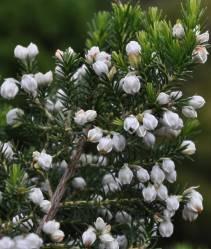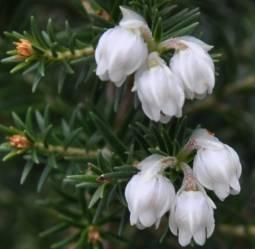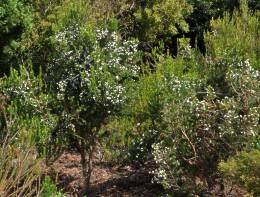Erica triflora
Erica triflora L.
Family: Ericaceae
Common names: bearded tree heath, three-flower erica (Eng.); baardboomheide (Afr.)
Introduction
Erica triflora has been in cultivation for a long time and appears on a list of heaths that were cultivated by Messrs Lee and Kennedy at Hammersmith, England in 1802.

Description
Description
Erica triflora is a sturdy, erect shrub and may under favourable conditions grow to be a small tree up to 3 or even 4 m tall. It has a stout woody trunk and branches freely to form a rounded bush, which is covered with clusters of dark green to almost black leaves. The corolla is 5 mm long and bell- or urn-shaped, and flowers occur in clusters of three at the tips of the branches. The flowers vary, depending on locality, with those on Table Mountain being white whereas plants on the Hottentots Holland and adjacent mountains have smaller flowers, which may be tinged with pink.

Conservation Status
Status
Erica triflora is not threatened.
Distribution and habitat
Distribution description
Erica triflora is limited to the northern section of the Cape Peninsula mainly on the upper slopes of Table Mountain and Devil's Peak. It also occurs on the Hottentots Holland Mountains, north to Porterville and across to the Kogelberg Mountains. It prefers to grow on the cooler, upper, south-facing slopes in well drained and seasonally moist sandy soils.
Derivation of name and historical aspects
History
The name is derived from the Latin words, tri florus, which mean three-flowered, referring to the arrangement of the flowers in groups of three.

Ecology
Ecology
Erica triflora occurs on the upper slopes of the mountains of the Western Cape where the climate is a bit cooler in summer. Some of these mountains are blanketed with summer south-easter cloud that provides extra moisture. It grows in nutrient-poor and sandy soils, often on steep slopes. This species flowers from July to November and is pollinated by bees.
Uses
Use
Erica triflora is an interesting addition to a fynbos garden or can be grown as a pot plant.

Growing Erica triflora
Grow
Erica triflora is very similar to the much sought after Erica baccans, but is not as easy to grow. Plants grow well enough in pots, but they are less hardy in the garden. Experience at Kirstenbosch has shown that the species is best planted in a cooler spot or where it is partially shaded. It is also advisable to plant it close together with other species of Erica or fynbos companion plants such as proteas, pincushions, buchus, brunias and restios.
Plant this Erica in a medium-sized container in a suitable, well-drained growing medium. A fynbos planting medium is made up of a combination of equal parts composted pine bark or pine needles and river sand. A little (20%) loam may also be added. It is a tall-growing species, so regular pruning is recommended to keep the plants well branched and compact. Plants that are pruned are more presentable, last longer and produce more flowers.
Erica plants are adapted to living in poor soils. Nevertheless, they should be regularly fed with low concentrations of diluted organic liquid or small amounts of organic pellet fertilizers.
It is propagated vegetatively by rooting fresh semi-hardwood tip or heel cuttings. Cuttings are rooted in multi-trays on heated benches under mist spray. Cuttings are rooted in autumn or spring in a rooting medium of equal parts bark and polystyrene chips. A semi-hardwood rooting hormone is used to aid the rooting process.
This species grows easily from seed when subjected to smoke treatment and sown in well-drained, acidic, sandy soil. Seed is normally sown from late summer into autumn, i.e. March to May.
References
- Adamson, R.S. & Salter, T.M. 1950. Flora of the Cape Peninsula. Juta, Cape Town and Johannesburg.
- Andrews, H.C. 1854. The Heathery, 6 vols. London.
- Flora Capensis 4,1. 1909. Lovell Reeve, London
- Goldblatt, P. & Manning, J.C. 2000. Cape plants. A conspectus of the Cape flora of South Africa. Strelitzia 9. National Botanical Institute, Pretoria and Missouri Botanical Garden Press.
- Oliver, I. & Oliver, E.G.H. 2000. Field guide to the ericas of the Cape Peninsula. Protea Atlas Project, National Botanical Institute, Cape Town.
- Schumann, D. (Dolf) & Kirsten, G. (Gerard). 1992. Ericas of South Africa. Fernwood Press, Vlaeberg, Cape Town.
- Coates Palgrave, M. 2002. Keith Coates Palgrave Trees of southern Africa, edn 3. Struik Publishers, Cape Town.
- http://redlist.sanbi.org
Credits
Anthony Hitchcock
Kirstenbosch National Botanical Garden
October 2010
Plant Attributes:
Plant Type: Shrub
SA Distribution: Western Cape
Soil type: Sandy
Flowering season: Spring, Early Summer, Winter
PH: Acid
Flower colour: White
Aspect: Full Sun
Gardening skill: Average
Special Features:
Horticultural zones







Rate this article
Article well written and informative
Rate this plant
Is this an interesting plant?
Login to add your Comment
Back to topNot registered yet? Click here to register.